
The Reno/Tahoe/Carson area of northwestern Nevada has held my interest ever since I started fly fishing thirty-plus years ago. The Truckee River has always been known as Nevada’s premier trout river. It is historic for many reasons, but for fly fisherman especially it is known for its historic runs of Lahontan cutthroat trout that would run up from Pyramid Lake. But living in Las Vegas, that 450 mile drive was a deterrent to any short trip, and I was never comfortable about week-long fishing excursions taking me away from my family. Back in 1982 I was able to spend a long weekend in the Tahoe area, but I hadn’t been back to fish for 28 years.
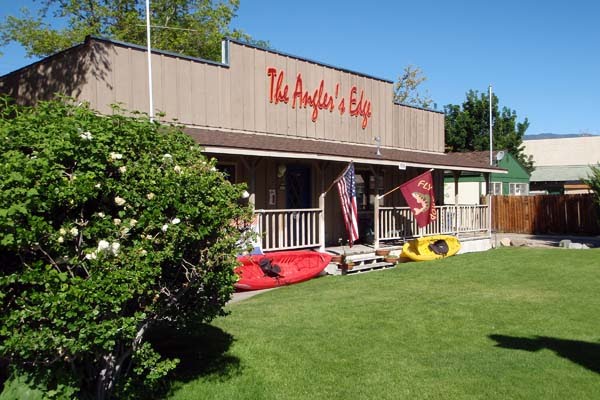
Now I travel to Carson City routinely for Nevada Public Employee Retirement board meetings. This spring I started to develop the idea of flying up early and spending a few days fishing the area before the board meeting. Googling for possible streams in the area consistently turned up the East Carson River (check out Mike Wier’s East Carson video for example). The East Carson is about a forty-five minute drive from Carson City, which made it very convenient. Furthermore, I assumed that it received less pressure than the Truckee, and perhaps was more amenable to my underdeveloped wading abilities. It seemed like a good place to start, anyway.

I was anxious to get going Monday morning but something told me I should check in with the Angler’s Edge fly shop in Gardnerville, Nevada to get some advice. Unlike my usual impatient self, that proved useful. The woman working at Angler’s Edge told me the East Carson was flowing too high and dirty for any fishing pleasure (she checked on-line for current flow data). I asked her if she had a recommendation and she directed me to the East Walker River on the Rosaschi Ranch site. She even printed two customized Angler’s Edge maps for my use. Way cool! I was compelled to purchase an Angler’s Edge cap out of gratitude.
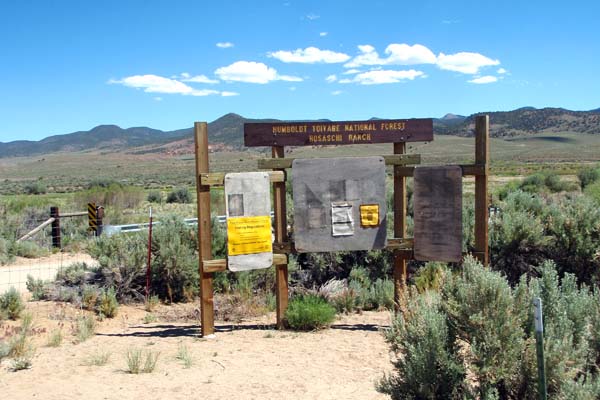
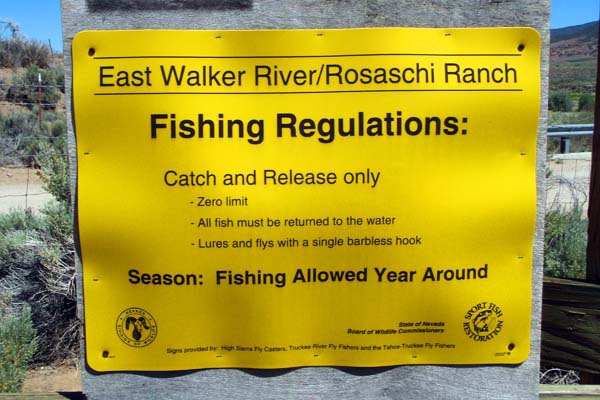
The drive to Rosaschi Ranch from Gardnerville is very relaxing. Veering off Highway 395 (which parallels the eastern side of the Sierra’s) and heading east on Highway 208 to Yerington, NV, you then catch Highway 338 south between the Sweetwater Mountains to the west and the Pine Grove Hills to the east. Simply Nevada beautiful; those of you used to driving the highways of the upper Great Basin will understand what I mean. I was to look for the gravel road turn off to the Rosaschi Ranch, but I missed it by about thirty feet. Backing up and continuing down the dirt road I quickly recognized the high desert riparian habitat cradling the East Walker River. Shortly I came upon the parking area right next to the Rosaschi Ranch sign postings. One little Toyota truck was already there, and a big Ford transporting a dad and two teenage sons pulled up immediately after me. The teenagers were in a hurry, as is their youthful tendency, but the dad talked a little, saying they had caught a few “normal” sized trout but the boys had also landed eighteen and nineteen inch trout. They were already in waders and their fully assembled rods were secured on hood holders and so they were off upstream from the bridge before I could even start assembling my rod, yet alone slip on my new hip waders. I decided to use my four-weight, seven-and-one-half foot rod with a floating line.
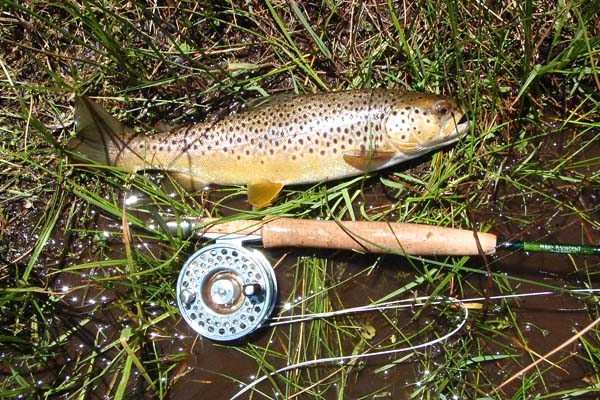
Since those three headed upstream, I chose downstream. Besides, the terrain seemed simpler for my leg circulation and I wanted a more leisurely pace. I admit that for the past ten years I had been focusing more on still water fishing, and I had a sense of anxiousness about my ability to read and fish a larger river. But my stream reading skills honed on Beaver Dam and Mammoth creeks were still effective. I knew were the trout were. I settled into a nice section about two-hundred yards downstream from the bridge. I rigged up a nymph dropper off a Humpy I was using as a strike indicator. After a few swings though a likely looking run against the far bank I got a few looks from the depths. The water wasn’t gin clear, but amber, and the golden flashes that followed the Humpy were evidence of the brown trout I was looking for. But I just couldn’t seem to get them to take either fly. Finally after what seemed like thirty minutes I got a nice twelve-inch brown to take the Humpy. The current was swift and the trout tried to use it to his advantage but I was able to bring him to the bank. To my dismay the trailing nymph was tangled around the trout and so it took a few seconds to figure that out before I could snap a few pictures.
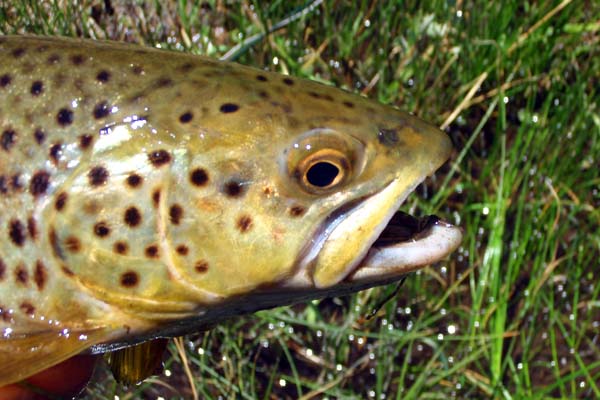
Wanting to settle the run down for another try I decided to head a little further downstream. From the side of the bank that I was on the river was a little deeper, closer to crotch depth and thus rendering the hip waders useless. There were several likely feeding stations but either I couldn’t effectively reach them or I just didn’t present the right fly in the right way. After a while I headed back upstream to my first location. This time I eliminated the nymph dropper and used the Humpy alone. Within a few casts I had another missed strike, and then a while later landed my second East Walker brown, this one with many of those signature red spots.

Unfortunately I neglected to bring drinking water with me, and there was none in the rental car. After four hours in eighty-degree temperature I was showing signs of dehydration. I left Rosaschi Ranch after about four hours of fishing (two missed strikes and two brown trout landed by hand) and I headed for Bridgeport, CA for lunch, hydration, and assessment.
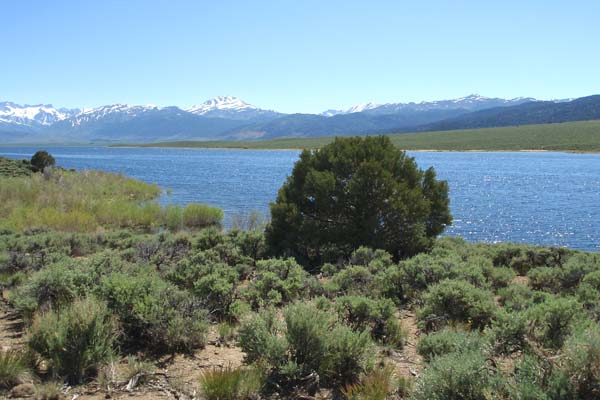
Reservoir.
One reason the East Walker was running clearer is that the Bridgeport Reservoir works to settle whatever silt and debris the spring floods drag from the east slope Sierras. Driving towards Bridgeport on Highway 338 (Highway 182 on the California side) it was not difficult to see the anglers all along the river, especially the few miles just below the dam. I made note of that. I must say that I wasn’t really prepared for the vision of the Sierra Nevada Mountains behind Bridgeport as the car rose out of the river valley canyon onto the plane that held the reservoir. The plethora of peaks, ranging from 10,800 to over 12,000 feet, was awesome to behold (Crater Crest, Twin, Kettle, Robinson, and Eagle peaks encircle the Mono Village town up in the Twin Lakes canyon).
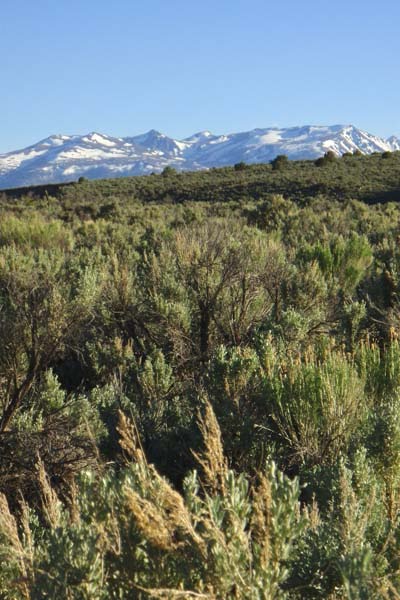
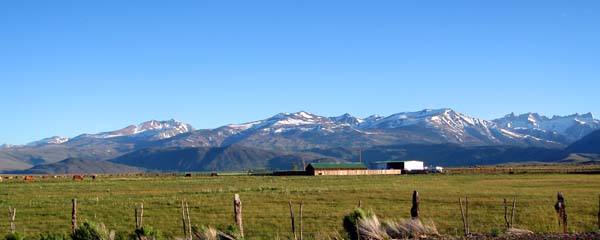
Although significantly more crowded than the Rosaschi Ranch portion on the Nevada side, I decided that I needed to fish the East Walker below Bridgeport Reservoir. After finding one of the numerous turn-offs from Highway 182 I discovered that the chest-high sage had well-worn paths, each leading to the river. The difficult part was finding a section of river to stake out. It seemed as if there was a fisherman on every hundred-yard stretch of water. I was lucky that it didn’t take long to take over a section that a spin fisherman was vacating. It turned out to be a good stretch. It had a riffle section coming straight down the middle and a few pools in the far side. Wading was simple even in my hip waders, and I could get into position easily. Still, these “educated” trout were hard to get to take the fly. I was surprised by how many would rise on the surface, sometimes within six feet of me, and yet refuse every feathery morsel I tried. I had several missed takes, but finally got a nice twelve inch brown on a dry fly about fifteen feet upstream from me in the riffles. Below and to the left of me was a nice sweeping hole. I worked that hole with numerous flies and tandem combinations, and I did not get any indications. Still, I knew it had to have trout in it. After a while I decided to move a little downstream as I saw the father/son duo below me begin to move downstream themselves. As I started to work past that sweeping hole I saw a brown of sixteen to eighteen inches dart out and then back into his hole… I just knew he was in there.
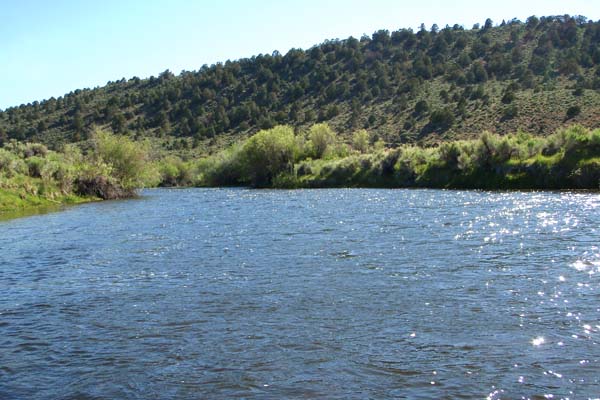

As the sun began to set behind the Sierra’s I started to move through the next downstream section a little more swiftly. Eventually over my right shoulder I heard “Mister!” There it was again, so I turned to look. There was this young boy, maybe eight or nine years old, with a large trout in his dad’s catch-and-release net. “Hey mister, does this trout look eighteen inches to you?” He had set the hook on me, so I waded to shore to inspect the trout. Sure enough, by my estimations it was a long, sleek brown trout of about nineteen inches. The tip of my thumb to the tip of my pinky is just shy of nine inches, outstretched. This trout was about an inch or two beyond two hand measurements. “Nice job”, I said to the lad. Satisfied, he walked off to return to his father. I don’t know if the boy or his dad caught that trout, but it didn’t matter. The fishing regulations on that stretch of the East Walker didn’t matter to me either, since I always release my fish, but I had to suppose that you could keep one trout over eighteen inches. Despite the fishing traffic, which I usually abhor, I must say this stretch of the East Walker was most beautiful, particularly because of the Sierra Nevada backdrop. What it must have been like to fish this water fifty years ago.
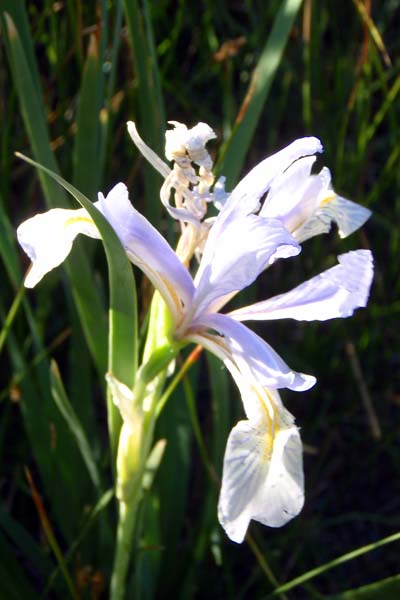
On Tuesday morning I decided to drive up to the East Carson near Markleeville, CA to see for myself the condition of the water and to visualize the area for a possible return trip. I had to be in Carson City by 3:00pm, and so I didn’t anticipate fishing much if at all. Sure enough, the Angler’s Edge was right about the raging East Carson. It was a soupy tan color flowing wide and deep. Still, you could see the promise it held. I did note one fly fisherman on the “catch and release only” section between the Highway 89 bridge and the confluence with the Markleeville Creek. I will be pondering a return trip, maybe in the fall.
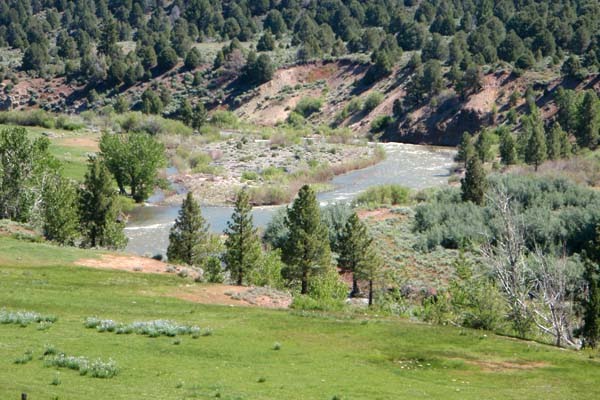
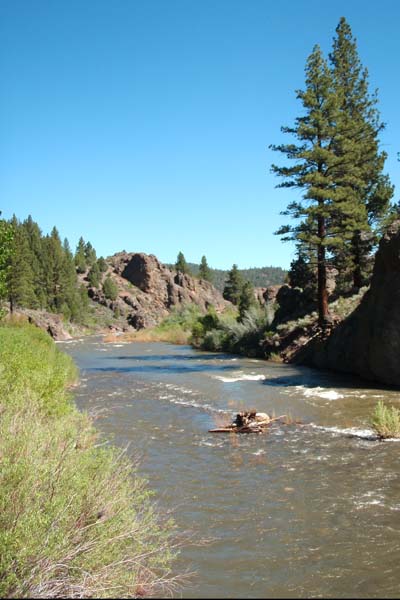
On the way out, about noon or so, I noticed a sign for Indian Creek Reservoir. Since I still had a few hours to kill before the meeting I decided to give it a try, just for amusement purposes. The reservoir was not as pretty as one might hope, and the wind coming down the east slope of the Sierra’s was blustery. I hiked down to what I thought would be the spot most sheltered from the high winds. Turned out it was the boat launch area, and there were three bait fisherman on the shore. I spoke with them and they indicated the fishing was slow, but when I walked over to the weeds a hundred yards around the bend I noticed many trout rising ten to seventy feet off shore. I returned to the car to gear up, and by the time I got back one of the bait fishermen had slid over into the weed area. Half laughing I said to him, “You saw what I saw, huh?” “Yep”, he replied. We were able to share the area just fine, however.
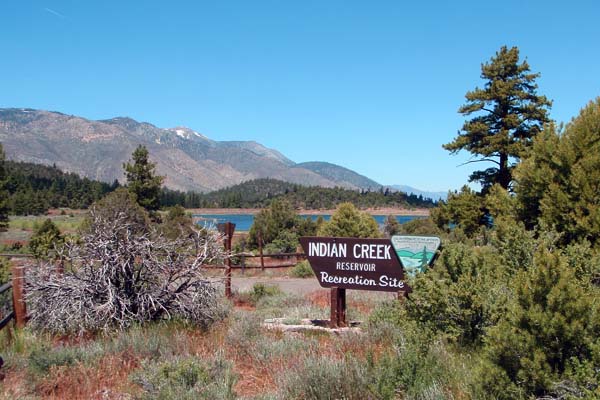

As I have written often before, ninety percent of the time trout feed under the surface, thus dictating a sinking or sink-tip line. I grabbed my eight-foot, five weight rod and my sink tip line. Man, was that the wrong choice. I continually snagged in the weeds about fifteen feet from shore, and the trout were obviously feeding on something off the surface. In an hour of fishing I missed one take but did manage to land one eleven inch rainbow, thus maintaining my current streak of no “fishing skunks,” as they say. But I want to tell you that there were large trout rising all around, and I should have used the floating line. In desperation I even cast a Humpy (based on the lower East Walker success) with that sink-tip line, but no luck (the wings, tail, and back on the Humpy are constructed with deer hair, which is highly buoyant, thus compensating for the line tip which sank rapidly). Although frustrating, I had a good time for an hour. On my way up the hill I noticed lots of damsel flies amongst the shoreline grasses and I had to wonder about casting a damsel imitation with a floating line… oh well. Back at the car I had a distinguished man of about sixty-five years cross my path and ask about the fishing. He, too, was a fly fisherman. I shared my results with him and offered my observation about the damsel flies. With a twinkle in his eye he said, “Yes, I noticed them, too, when I was watching you fish earlier.” Smart old man.
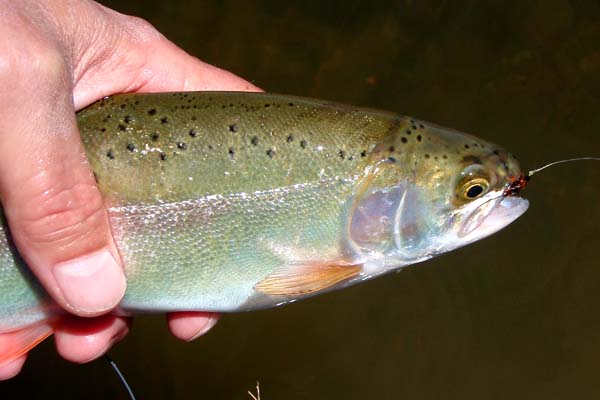

This trip had a measure of success; three different waters all producing respectable trout. More importantly it gave me a sense of the area, the “lay of the land”, so to speak. Next time back I’ll have a little more confidence and familiarity. I just hope it’s not another twenty-eight years before I return to fish the water there.

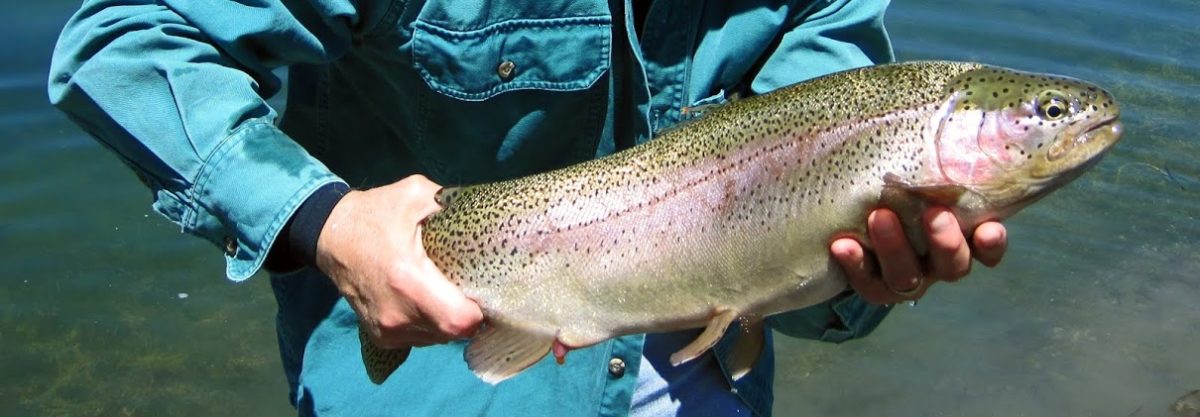
Ken sent me this blog. Very entertaining. You can move upstream on both the Carson and Walker in the summer months, of course depending on the year. You must be willing to get a California license. Although these waters are good, the Yosemite and Mammoth back country lakes and streams might do the trick for you. What you did discover is what many Reno residents are well aware of; South of Carson City down toward Bridgeport and Mammoth are much more fertile waters offering a greater variety of fishing than the over fished Truckee.
Thank you for the feedback. Very much appreciated. I hope to figure out how to spend more time up north, but with a new foster baby at home I'll have to see. By the way, I did have a CA license for Monday/Tuesday, so I was legal (smile).